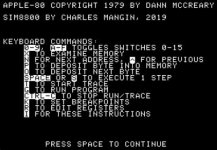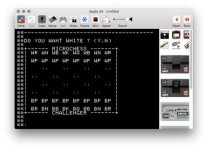retroconnector
Member
- Joined
- Sep 27, 2016
- Messages
- 27
I'm working on an Altair 8800 simulator that runs on the Apple II.
Yes, emulating one old computer on another. This is made possible by an 8080 emulator written for 6502 by Dann McCreary in 1977, then ported to Apple II in 1979. I've updated the emulator and added a graphical front end to simulate the front panel of the Altair 8800.
Not being terribly familiar with the 8800 other than what I've seen on YouTube and some scanned PDFs, I'd like the feedback from some other testers.
You will need an Apple II (II+, IIe, IIc) or an emulator like Virtual II, some way to boot a DSK, and a color display.
Please PM me if you want to give it a try and can give good feedback on how well it emulates a real 8800.
Screenshots to whet your appetite:


Yes, emulating one old computer on another. This is made possible by an 8080 emulator written for 6502 by Dann McCreary in 1977, then ported to Apple II in 1979. I've updated the emulator and added a graphical front end to simulate the front panel of the Altair 8800.
Not being terribly familiar with the 8800 other than what I've seen on YouTube and some scanned PDFs, I'd like the feedback from some other testers.
You will need an Apple II (II+, IIe, IIc) or an emulator like Virtual II, some way to boot a DSK, and a color display.
Please PM me if you want to give it a try and can give good feedback on how well it emulates a real 8800.
Screenshots to whet your appetite:




